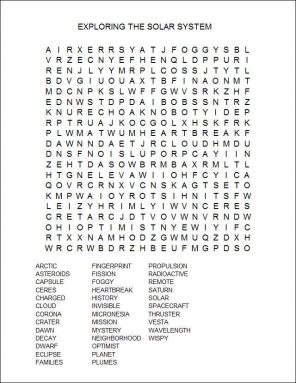Cool Jobs: Exploring the solar system
These scientists are solving mysteries about our planet’s neighborhood
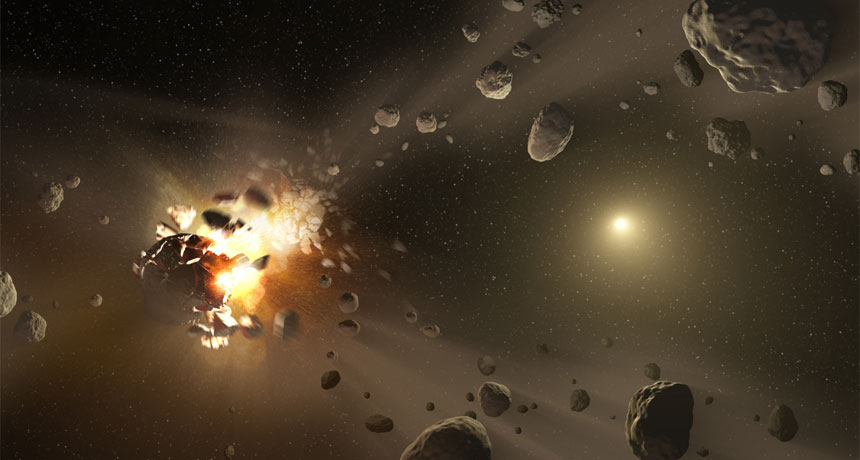
Artist's depiction of how families of asteroids are born. Since our solar system’s birth, asteroids orbiting in the belt between Mars and Jupiter have collided. The rocky debris yields more asteroids. Researchers study such members of our planetary family to better understand Earth and its neighbors.
NASA/JPL-Caltech
By Ilima Loomis
Even from a distance, scientists on NASA’s Dawn mission noticed something unusual about Ceres. This dwarf planet is the largest object in the solar system’s vast asteroid belt. It looked cold, barren and rocky. But that wasn’t the surprise. It was those strange white spots.
As the spacecraft approached its destination, it began sending home more and better pictures of Ceres (SEER-ees). But they didn’t solve the mystery.
“It’s been fun getting more detailed images of the white spots,” says Todd Barber. “They get more and more intriguing, but we still don’t know what they are.”
Barber isn’t an astronomer or planetary scientist. As a propulsion engineer, he plays a key role in helping scientists explore the asteroid belt: He steers the Dawn spacecraft. What Dawn reveals about Ceres and Vesta, another large asteroid the spacecraft visited, could help explain how our solar system formed.
People have been studying the sun and planets for thousands of years. Scientists, though, still have many questions about Earth’s neighborhood. They search for clues about what the solar system looked like in its earliest days, how planets were born and how they ended up where they did.
And although it makes life possible on our planet and holds the entire solar system together, the sun — and how it works — might be the biggest mystery of all.
Here are three people who are helping to explore and understand our solar system, from its fiery center, to the distant asteroid belt and those frozen worlds beyond.
Steering a spacecraft
When Barber was asked to join Dawn, he was excited. An engineer at NASA’s Jet Propulsion Laboratory in Pasadena, Calif., he had already worked on the Mars Curiosity rover mission and the Cassini spacecraft. That last one was studying Saturn. Now he would get to work on a spacecraft exploring two of the most intriguing objects in the asteroid belt.
The main belt is a vast, donut-shaped cloud of space rocks. It floats between Mars and Jupiter. Scientists believe this rubble was left over after true planets in the solar system formed. Studying this belt of rubble should offer clues to the raw materials that created the planets.
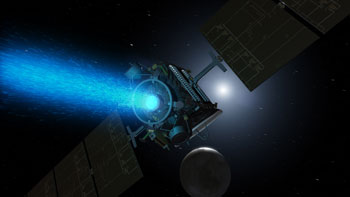
Vesta is one of the largest asteroids in the belt. Dry and rocky, its resembles planets of the inner solar system, such as Mars and Earth. Ceres looks more like the icy moons of the outer solar system. NASA scientists hoped its two new asteroid targets would reveal clues about two different space environments.
By the time Barber joined the team in 2014, Dawn had finished studying Vesta and was on its way to Ceres. The plan was for the spacecraft to approach Ceres and drop into orbit. It would fly lower and lower, taking pictures and mapping the surface of this dwarf planet. It would continue making observations from that low orbit until the spacecraft ran out of fuel.
But less than three weeks after Barber started working on Dawn, there was a problem. One moment the spacecraft was thrusting toward Ceres. The next, it shut itself down and went to sleep. The spacecraft had entered “safe” mode. It’s a way to protect itself when something goes wrong.
Each day the spacecraft was shut down would delay its arrival at Ceres by nine days. So Dawn was quickly falling behind in its race to catch up with Ceres’ orbit.
Barber and his new teammates worked around the clock to understand what went wrong — and then how they might fix it. They were really concerned. Over time, they had become attached to the little probe and wanted to make sure it was OK. “We think of these things as if they’re humans,” Barber explains. “They have personalities and quirks. When a family member is in trouble, you drop everything to go help them. And that’s how you feel about these spacecraft.”
Finally, after four days, they found the problem. A tiny, radioactive particle had struck the spacecraft. It had damaged an electronic part. To fix Dawn, they send the craft radio commands on what to do. In short order this got it back on course and everyone was relieved, Barber recalls. “JPL threw us a pizza party to celebrate.”
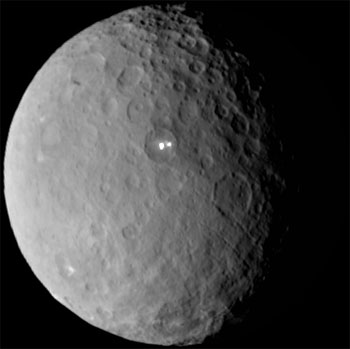
Even though Dawn finished its trip across space and arrived at Ceres in March of this year, Barber still needs to help steer it. The spacecraft must face Ceres when scientists want to take pictures, then turn and point an antenna toward Earth to send those pictures home. Barber controls and cares for the thrusters used to steer Dawn through these maneuvers. “We point the spacecraft, we turn the spacecraft to and from the asteroid, we control its orientation in space,” he says. Those thrusters fire small rockets to push the spacecraft in different directions.
Barber checks things like fuel tank pressure and temperature. He monitors the opening and closing of valves on the thrusters to make sure the propulsion system is working properly. He also carefully reviews any planned movements. A mistake could cause the spacecraft to crash.
“We have to be very careful with any commands we send to the spacecraft, to be sure we’re not telling it to do something stupid,” he explains.
Barber loved science from an early age. “I was a mad chemist, burning holes in the pavement and begging my parents to pipe [natural] gas into my room for a Bunsen burner,” he recalls. (They wisely refused.) Later, he became fascinated with the Voyager missions to Saturn and Jupiter and fell in love with planetary science. In college and graduate school, he realized he could use his passion for chemistry and engineering to help explore the solar system. So he studied aeronautics and rocket propulsion.
Today, his favorite part of working on Dawn is sharing in the mission’s discoveries.
“I’m right there with the scientists when the first pictures come back,” he says. “I totally get jazzed by seeing stuff nobody’s ever seen before.”
Opening an asteroid “time capsule”
What’s inside an asteroid? Cristina Thomas hopes the answer might help explain how the solar system formed some 5 billion years ago. This planetary astronomer studies asteroid “families.” These are clusters of rocks and rubble floating in space that all came from a big parent asteroid. That parent had een struck or smashed to pieces during some large cratering event.
By looking at those smaller rocks, she hopes to see what had been inside their bigger parent. Thomas is a research scientist at NASA’s Goddard Space Flight Center in Greenbelt, Md. She works for the Planetary Science Institute and Universities Space Research Association.
The families she hunts for are young, just a few hundreds of millions of years old. “These young families are my time capsules from the early solar system,” she says. “They have been opened fairly recently, and I hope that was enough to preserve what was inside.”
Thomas studies sunlight bouncing off of these rocks to find out what they’re made of. She knows that every element reflects light in a unique pattern of wavelengths, called a spectrum. The pattern is like a fingerprint. She uses a tool called a spectrograph to break apart the light reflecting off asteroids into its different wavelengths, much like a prism separates white light into a rainbow. Then she compares the spectra from the asteroids with those of elements found on Earth until she finds two that are the same.
“It’s a matching game,” she says.
When there’s an asteroid Thomas wants to study, she must first write a proposal. It’s a document that explains what she’d like her project to tackle. It also asks for time on the telescope she hopes to use. She often uses NASA’s Infrared Telescope Facility. The telescope is in Hawaii, but Thomas can make her observations from the computer in her home. When it’s her night to observe, she logs in to the facility’s computer with a special password and calls the telescope operator. “Then I put on a pot of tea and prepare to stay up all night,” she says.
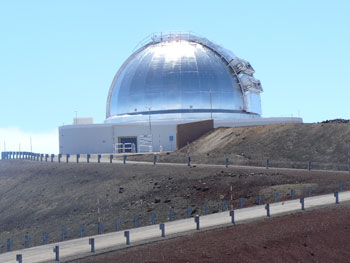
She tells the operator where to point and when to focus the telescope. Then Thomas starts collecting data. “I’ll wake up the next morning or afternoon and download all the data,” she says.
One mystery has been perplexing Thomas. Planetary scientists have gathered plenty of evidence that suggests large asteroids should have melted at some time in their history. Some elements in the rock are radioactive. Radioactive materials shed energy — heat — as they decay (shed particles as their elements fission). That heat should have caused melting. And if they melted, the rock should have differentiated. That means its materials should have separated into layers, with the densest elements settling at their cores.
Scientists know this happened. They just cannot find evidence of it in the asteroid population. Where did that melted material go?
“What we see in the main belt now is very different from what we assumed would be there,” Thomas says.
She hopes to find out whether the rocks within an asteroid family all look the same, or whether smaller rocks are different from bigger ones. “Is there any evidence that they melted in the past?” she wonders. “If we can figure that out, then we can start to understand what happened in the early solar system.”
Eclipse chaser
The sun is Earth’s closest star. But because the sun’s extreme heat and radiation make it difficult to investigate up close, there still are many things scientists don’t understand about how it works. Why, for instance, is the sun’s corona — its outer atmosphere — more than a million degrees hotter than its surface? And what’s the source of the solar wind, a powerful stream of charged particles that flows out from the sun?
Next to the brilliant solar disk, and against a bright blue sky, the corona is almost invisible. That’s one reason Shadia Habbal is willing to travel to some of the most remote places in the world to observe a total eclipse of the sun. She is a solar physicist at the University of Hawaii Institute for Astronomy in Honolulu.
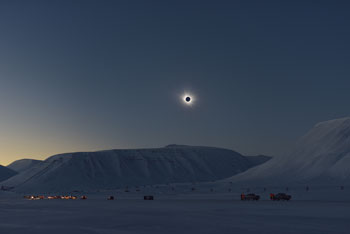
During a solar eclipse, the moon passes directly in front of the sun. Seen from Earth, it appears to cover the solar disk. As the moon’s shadow passes over Earth, the sky turns dark and stars can be seen, even though this occurs during daylight hours. For a few minutes of “totality,” when the moon is directly in front of the sun, the corona will become the brightest thing in the sky.
At that time, “you can see much further out in the corona,” Habbal says. Astronomers can study the corona’s intricate structures, from its bright inner ring to the wispy plumes of plasma that stretch far out into space.
Her goal is to discover what part of the sun the solar wind comes from. For years, many scientists have argued that it comes from the sun’s poles, or from other features called coronal holes, parts of the corona that are cooler and thinner. But Habbal has a different theory. “For a long time, I felt it was from all over the solar surface. But I have yet to prove it,” she says.
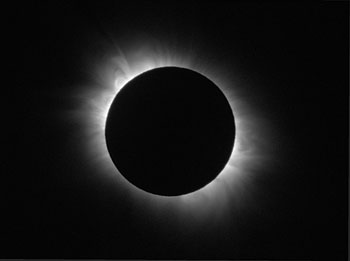
When Habbal looks at an eclipse, she sees energy flowing out from the sun in every direction. She hopes to find evidence that the solar wind behaves in a similar way.
During an eclipse, she takes pictures of the corona using special filters to see a unique wavelength of light. That wavelength is due to the heating of iron atoms in the sun’s corona.
Some atoms in the corona have been changed by radiation and heat. By using different filters, she can compare the properties of iron atoms found in the corona with those carried into interplanetary space on the solar wind. That should give her clues about how the corona and the solar wind might be linked.
But studying eclipses isn’t easy. Total eclipses occur only about 75 times in every century. They last no more than a few minutes. And the path of the moon’s shadow often falls only on remote or extreme parts of Earth. Habbal must carefully plan how to get her team of up to 20 scientists and technicians to these sites, along with their delicate instruments and equipment.
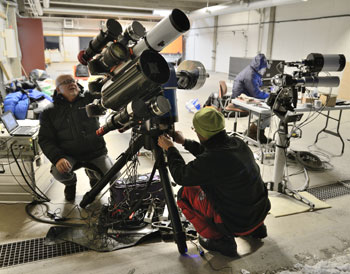
To see eclipses, she has already traveled to tiny atolls in Micronesia, to the middle of the Libyan desert in northern Africa, to the African bush and to a frozen island in the
Arctic circle
. She’s one of many eclipse chasers who is planning to educate the country about safely viewing a solar eclipse that will pass across the United States in 2017.
And even though she spends years planning her expeditions, some end in heartbreak. After traveling for days across rough terrain to set up their equipment, a sudden rainstorm, a passing cloud or a foggy day might prevent her team from seeing an eclipse. When that happens, they go home empty handed. Yet Habbal won’t go home discouraged. Already she will be thinking about her next eclipse.
“You have to be an optimist,” she says. “The drive is so strong that you have to try again. I’ve met a lot of eclipse chasers, and I haven’t met a single one that’s given up. It becomes an addiction.”
Humans still know little about our closest neighbors in the universe — the sun, planets and other bodies that make up our solar system. But we’re curious. So researchers like the ones we’ve just met here have made it their job to investigate science and cosmic history in our own backyard.
This is one in a series on careers in science, technology, engineering and mathematics made possible with generous support from Alcoa Foundation.
Power Words
(for more about Power Words, click here)
aeronautics The study of flight and development — or refinement — of craft to move through air or space.
asteroid A rocky object in orbit around the sun. Most orbit in a region that falls between the orbits of Mars and Jupiter. Astronomers refer to this region as the asteroid belt.
astronomy The area of science that deals with celestial objects, space and the physical universe. People who work in this field are called astronomers.
atoll A ring-shaped island formed from a coral reef that surrounds a lagoon.
atom The basic unit of a chemical element. Atoms are made up of a dense nucleus that contains positively charged protons and neutrally charged neutrons. The nucleus is orbited by a cloud of negatively charged electrons.
bush (in landscape descriptions) The name for wild lands in certain countries, especially parts of Africa and Australia.
Ceres The largest known asteroid orbiting the sun. It sits 270 million kilometers (nearly 168 million miles) from Earth in the asteroid belt between Mars and Jupiter. At about 1,000 kilometers (600 miles) across, Ceres is so big that it is classified as a dwarf planet. In 2014, astronomers found it spewing water from two places on its surface.
chemistry The field of science that deals with the composition, structure and properties of substances and how they interact with one another. Chemists use this knowledge to study unfamiliar substances, to reproduce large quantities of useful substances or to design and create new and useful substances. (about compounds) The term is used to refer to the recipe of a compound, the way it’s produced or some of its properties.
corona The envelope of the sun (and other stars). The sun’s corona is normally visible only during a total solar eclipse, when it is seen as an irregularly shaped, pearly glow surrounding the darkened disk of the moon.
cosmos (adj. cosmic) A term that refers to the universe and everything in it.
crater A large, bowl-shaped cavity in the ground or on the surface of a planet or the moon. They are typically caused by an explosion or the impact of a meteorite or other celestial body. Such an impact is sometimes referred to as a cratering event.
decay (for radioactive materials) The process whereby a radioactive isotope — which means a physically unstable form of some element — sheds energy and subatomic particles. In time, this shedding will transform the unstable element into a slightly different but stable element. For instance, uranium-238 (which is a radioactive, or unstable, isotope) decays to radium-222 (also a radioactive isotope), which decays to radon-222 (also radioactive), which decays to polonium-210 (also radioactive), which decays to lead-206 — which is stable. No further decay occurs. The rates of decay from one isotope to another can range from timeframes of less than a second to billions of years.
density A measure of the consistency of an object, found by dividing the mass by the volume.
dwarf planet One of the solar system’s small celestial objects. Like a true planet, it orbits the sun. However, dwarf planets are too small to qualify as true planets. Prime examples of these objects: Pluto and Ceres.
eclipse The temporary masking of one celestial body (such as the sun or moon) by another passing in front of it (from our vantage point on Earth). An eclipse can be full (or total), where the more distant object totally disappears for a time, or partial, where some part of it remains visible at all times to viewers on Earth.
element (in chemistry)Each of more than one hundred substances for which the smallest unit of each is a single atom. Examples include hydrogen, oxygen, carbon, lithium and uranium.
engineering The field of research that uses math and science to solve practical problems. People who do this work are known as engineers.
fission The spontaneous splitting of a large unit into smaller self-sustaining parts. (in physics) A process in which large atomic nuclei break apart to form two or more lighter nuclei. The excess mass of the parent nuclei (compared to the resulting smaller ones) is converted into energy.
graduate school Programs at a university that offer advanced degrees, such as a Master’s or PhD degree. It’s called graduate school because it is started only after someone has already graduated from college (usually with a four-year degree.
orbit The curved path of a celestial object or spacecraft around a star, planet or moon. One complete circuit around a celestial body.
physicist A scientist who studies the nature and properties of matter and energy.
planetary science The science of other planets besides Earth.
plasma (in chemistry and physics) A gaseous state of matter in which electrons separate from the atom. A plasma includes both positively and negatively charged particles.
propulsion The act or process of driving something forward, using a force. For instance, jet engines are one type of propulsion for keeping airplanes aloft.
radioactive An adjective that describes unstable elements, such as certain forms (isotopes) of uranium and plutonium. Such elements are said to be unstable because their nucleus sheds energy that is carried away by photons and/or and often one or more subatomic particles. This emission of energy is by a process known as radioactive decay.
rover A carlike vehicle, such as those designed by NASA to travel across the surface of the moon or some planet without a human driver. Some rovers also can perform computer-driven science experiments.
solar Having to do with the sun, including the light and energy it gives off.
solar eclipse An event in which the moon’s shadow covers the sun’s surface and reveals its outer layer, the corona.
solar system The eight major planets and their moons in orbit around the sun, together with smaller bodies in the form of dwarf planets, asteroids, meteoroids and comets.
solar wind A flow of charged particles (including atomic nuclei) that have been ejected from the surface of the star, such as our sun. It can permeate the solar system. This is called a stellar wind, when from a star other than the sun.
spectrograph An instrument used to record light and separate it into its spectrum.
spectrum A range of related things that appear in some order. (in light and energy) The range of electromagnetic radiation types; they span from gamma rays to X rays, ultraviolet light, visible light, infrared energy, microwaves and radio waves.
telescope Usually a light-collecting instrument that makes distant objects appear nearer through the use of lenses or a combination of curved mirrors and lenses. Some, however, collect radio emissions (energy from a different portion of the electromagnetic spectrum) through a network of antennas.
thruster An engine that pushes or drives with force by expelling a jet of fluid, gas or stream of particles.
wavelength The distance between one peak and the next in a series of waves, or the distance between one trough and the next. Visible light — which, like all electromagnetic radiation, travels in waves — includes wavelengths between about 380 nanometers (violet) and about 740 nanometers (red). Radiation with wavelengths shorter than visible light includes gamma rays, X-rays and ultraviolet light. Longer-wavelength radiation includes infrared light, microwaves and radio waves.
valve Something that can reduce or shut off the flow of some gas or liquid through a pipe or other passageway. Some specialized valves may allow a liquid or gas to flow in one direction only.
Word Find (click here to enlarge for printing)
